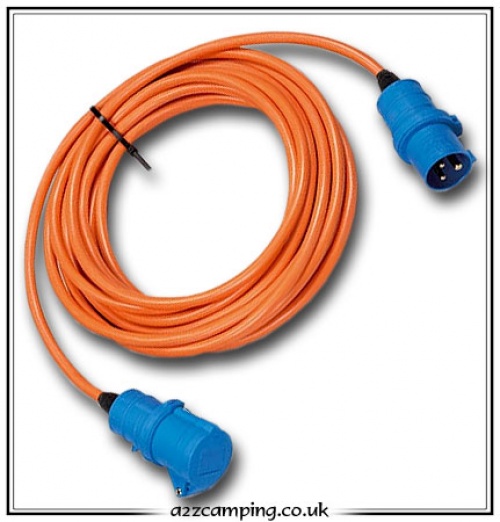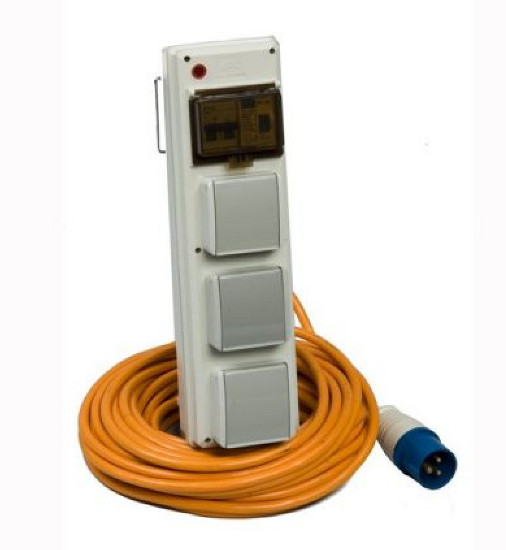Understanding electricity on the camp site!12 June 2012 | Admin Almost all modern campsites have a provision for mains power supplies, delivered via an electrical hook up post within each 'pitch'. This is by far the easiest way to power your television, laptop, hairdryer or even microwave on the go. But remember the camp site is responsible only for the safe delivery of electricity up to the outlet socket on the hook-up post. All campers have a responsibility to ensure that the cable from the post, the connection to their own caravan, motorhome or tent and that of the equipment being used is maintained to a safe level and respectful of other camp site users. Sites will not accept responsibility for the use of any unsafe or unsuitable equipment and reserve the right to instruct campers to disconnect such equipment. It is their site and their power supply after all. Normally the supply is 230V 50Hz single phase, much the same as you would find at home. Always make sure your camping equipment conforms to these standards, a label on the back or the bottom of your device will usually have this data. Your connection to the post must be fitted with a matching plug with either a suitable connection to your vehicle or a mobile mains on the other end. A2ZCamping.co.uk always recommend, and most sites insist that you have a trip (RCD) between the supply post and your equipment. Each hook up post is protected against power overload by both an RCD and a miniature circuit breaker (MCB). The MCB safely measures and limits the amount of current delivered to each pitch. Campsite mains supply have a maximum rating of 10 amps, although many have now increased this to 16 amps. But what does this mean for you? Know your limitations. Every appliance you connect to your mains supply will draw a current measured in Watts. A domestic kettle for example uses around 2,000 Watts or about 8 amps, a hair dryer around 1,000 Watts or 5 amps. Add a fan heater (3 amps) and a colour TV (0.5 amps) and you would already exceed the maximum 16 amp supply. Of course there are low watt camping alternatives to domestic appliances but care should always be taken not to exceed the camp site electricity supply limitations of 10 amps (2300 watts) or 16 amps (3680 watts), and remember if you do overload your camping power the post will trip and there will almost certainly be a charge to restore the supply. Its always a good idea to check that the electricity supply to your caravan or motorhome is working correctly. An inexpensive camping mains tester will verify that the supply is safe to use, a simple plug which shows at a glance the power supply status and polarity. It's true, tents are a little different from caravan and motorhome mains connections. Power to a tent is normally supplied via a mobile mains unit. Basically a site hook-up cable with an RCD and either one or several 3 pin plug outputs. Plug the mobile mains into the camp site supply post and away you go, power! A couple of pointers; the mobile mains will normally have a clip which allows you to clip it onto the frame of your tent or hang it up within the tent. Make sure you use these fittings, they ensure that the power supply is up off the floor and secured out of the way. And don't forget to pass the site plug end of the cable through your tents cable entry point before you plug it into the sites power supply; trust me, it's easy to forget this! The importance of the right cable. Much has been written about camp site electricity cables, caravan hook-up cables and mobile mains units. But the simple truth is that there are basically two types of cable; 10 amp hook-ups and 16 amp hook-ups. If you have read the information above then you'll already understand the difference. Many 16 amp cables are sold as Heavy Duty Mains Hook Up Lead whilst the 10 amps are currently the standard supplied cable. There is, of course, a price difference in the two cable types. Generally mobile mains units are supplied with 16 amp cabling, but do check before you make a decision. Never overload your cables rating, this will inevitably lead to the site post tripping out and may cause irreparable damage to your equipment. Most camping mains cables are supplied as either a 20 or 25 metre length and are normally coated in a waterproof hard wearing, high visibility coating. Where possible avoid joining two cable together. If you must join cables, the connections must be made by correctly wired and sealed plugs. The connection should also be raised off the ground and clearly identified to avoid any trip hazard. Site Plugs, conversion cables and sockets. One of the most common questions asked is "what plug/socket do I need?" The answer is fairly easy. If you're hooking up to a camp site power supply socket, you need a cable with one plug (male) and one socket (female) or a mobile mains unit if you're in a tent. The site post will have a female socket ready for the male end connection on your site hook up lead. Camp Site Supply Post: Socket (Female) Connection Caravan / Motorhome: Plug (Male) Connection Hook-Up Cable: One Male and One Female (Plug and Socket) To power your caravan or motorhome from your house you'll need UK Conversion Lead - a standard 3 pin plug with a short cable and a camp site socket connection. There are all sorts of combinations but the uk mains hook up cable remains at the heart of your power needs. For more information on campsite electrics, caravan hook ups or tent mobile mains units, please contact our expert team at www.a2zcamping.co.uk |
|
|| |



